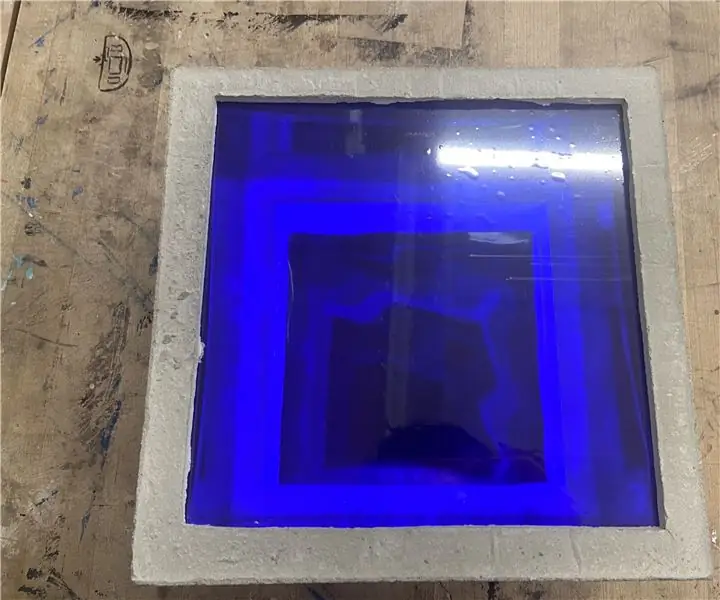
Innholdsfortegnelse:
- Forfatter John Day [email protected].
- Public 2024-01-30 11:22.
- Sist endret 2025-01-23 15:02.
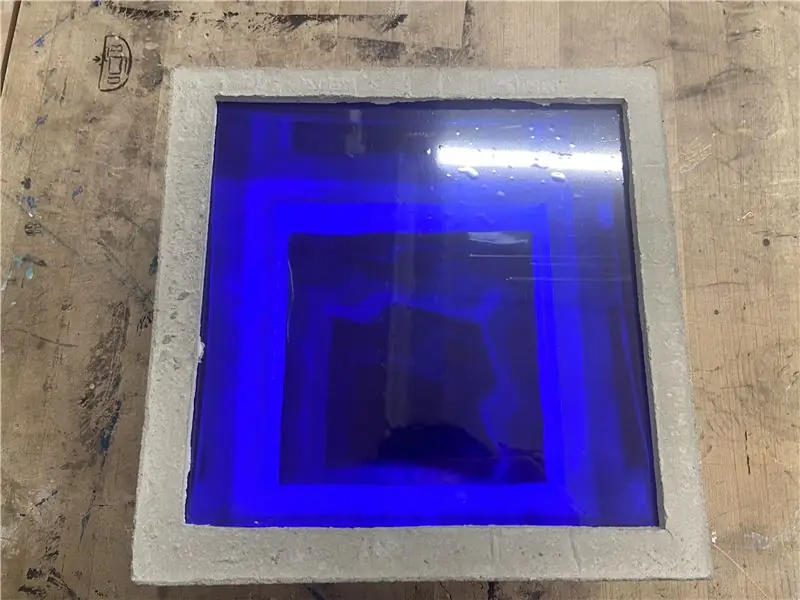
Dette er et kunstverk for LED -lysenheter for skulpturprosjektet mitt som heter Sacred Object. Jeg bruker denne enheten til å presentere en oppføring for en ny verden. Når jeg slår på LED -lyset, kan vi se en uendelig tunnel inne i betongboksen. LED -stripen styres via bluetooth på telefonen min. Jeg handlet alle rekvisita på Amazon.
Materialer:
- Arduino Uno
-LED stripe
-9v batteri
-DSD Tech SH-HC-08 Bluetooth 4.0 BLE-slavemodul
-330 Ohm motstand
- iPhone
-Betong
-Akryl
-Vindofilm (enveis speil)
-Dobbel sidespeilfilm
Trinn 1: Kretsdesign
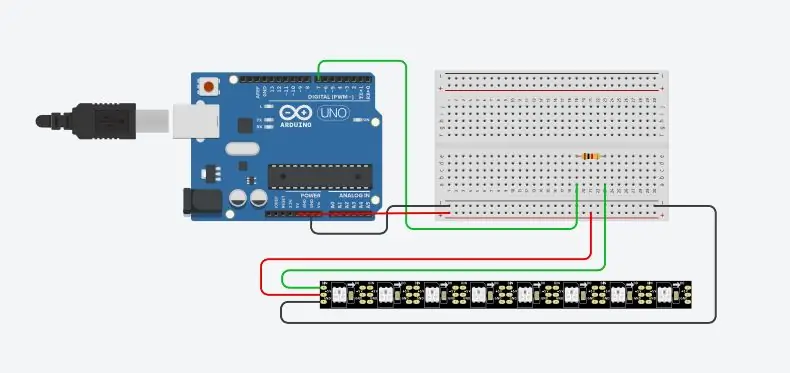

Slik får jeg kretsen til å fungere. Jeg laget også en sekvens for å simulere en bevegelse av hjernebølger.
Det første bildet er LED -stripekretsen.
Det andre bildet er Bluetooth -kretsen. Appen på iPhone er BluetoothLED.
Trinn 2: Arduino -kode
#inkludere
#define LED_PIN 7 #define NUM_LEDS 60 CRGB leds [NUM_LEDS];
ugyldig oppsett () {pinMode (LED_PIN, OUTPUT); Serial.begin (9600); FastLED.addLeds (leds, NUM_LEDS); }
void setBlue (int val) {for (int i = 0; i <NUM_LEDS; i ++) {leds = CRGB (0, 0, val); } FastLED.show (); } void loop () {
if (Serial.available ()) {val = Serial.read (); } hvis (val == 'H') {leds [0] = CRGB (0, 0, 0); FastLED.show (); leds [1] = CRGB (0, 0, 0); FastLED.show (); leds [2] = CRGB (0, 0, 0); FastLED.show (); leds [3] = CRGB (0, 0, 0); FastLED.show (); leds [4] = CRGB (0, 0, 0); FastLED.show ();
leds [5] = CRGB (0, 0, 0); FastLED.show ();
leds [6] = CRGB (0, 0, 0); FastLED.show ();
leds [7] = CRGB (0, 0, 0); FastLED.show ();
leds [8] = CRGB (0, 0, 0); FastLED.show ();
leds [9] = CRGB (0, 0, 0); FastLED.show ();
leds [10] = CRGB (0, 0, 0); FastLED.show ();
leds [11] = CRGB (0, 0, 0); FastLED.show ();
leds [12] = CRGB (0, 0, 0); FastLED.show ();
leds [13] = CRGB (0, 0, 0); FastLED.show ();
leds [14] = CRGB (0, 0, 0); FastLED.show ();
leds [15] = CRGB (0, 0, 0); FastLED.show ();
leds [16] = CRGB (0, 0, 0); FastLED.show ();
leds [17] = CRGB (0, 0, 0); FastLED.show ();
leds [18] = CRGB (0, 0, 0); FastLED.show ();
leds [19] = CRGB (0, 0, 0); FastLED.show ();
leds [20] = CRGB (0, 0, 0); FastLED.show ();
leds [21] = CRGB (0, 0, 0); FastLED.show ();
leds [22] = CRGB (0, 0, 0); FastLED.show ();
leds [23] = CRGB (0, 0, 0); FastLED.show (); leds [24] = CRGB (0, 0, 0); FastLED.show ();
leds [25] = CRGB (0, 0, 0); FastLED.show ();
leds [26] = CRGB (0, 0, 0); FastLED.show ();
leds [27] = CRGB (0, 0, 0); FastLED.show ();
leds [28] = CRGB (0, 0, 0); FastLED.show ();
leds [29] = CRGB (0, 0, 0); FastLED.show ();
leds [30] = CRGB (0, 0, 0); FastLED.show (); leds [31] = CRGB (0, 0, 0); FastLED.show ();
leds [32] = CRGB (0, 0, 0); FastLED.show ();
leds [33] = CRGB (0, 0, 0); FastLED.show (); leds [34] = CRGB (0, 0, 0); FastLED.show ();
leds [35] = CRGB (0, 0, 0); FastLED.show ();
leds [36] = CRGB (0, 0, 0); FastLED.show ();
leds [37] = CRGB (0, 0, 0); FastLED.show ();
leds [38] = CRGB (0, 0, 0); FastLED.show ();
leds [39] = CRGB (0, 0, 0); FastLED.show ();
leds [40] = CRGB (0, 0, 0); FastLED.show ();
leds [41] = CRGB (0, 0, 0); FastLED.show ();
leds [42] = CRGB (0, 0, 0); FastLED.show ();
leds [43] = CRGB (0, 0, 0); FastLED.show (); leds [44] = CRGB (0, 0, 0); FastLED.show ();
leds [45] = CRGB (0, 0, 0); FastLED.show ();
leds [46] = CRGB (0, 0, 0); FastLED.show ();
leds [47] = CRGB (0, 0, 0); FastLED.show ();
leds [48] = CRGB (0, 0, 0); FastLED.show ();
leds [49] = CRGB (0, 0, 0); FastLED.show ();
leds [50] = CRGB (0, 0, 0); FastLED.show ();
leds [51] = CRGB (0, 0, 0); FastLED.show ();
leds [52] = CRGB (0, 0, 0); FastLED.show ();
leds [53] = CRGB (0, 0, 0); FastLED.show (); leds [54] = CRGB (0, 0, 0); FastLED.show ();
leds [55] = CRGB (0, 0, 0); FastLED.show ();
leds [56] = CRGB (0, 0, 0); FastLED.show ();
leds [57] = CRGB (0, 0, 0); FastLED.show ();
leds [58] = CRGB (0, 0, 0); FastLED.show ();
leds [59] = CRGB (0, 0, 0); FastLED.show ();
forsinkelse (100); } annet {for (int i = 255; i> 0; i--) {setBlue (i); forsinkelse (10); } for (int i = 0; i <255; i ++) {setBlue (i); forsinkelse (10); }}}
Trinn 3: Lag beholder



Boksen er laget av betong. Jeg bruker skumplater til å lage en hul boks som skal støpes med betong. La det tørke i minst 24 timer.
Trinn 4: Laserskjæring
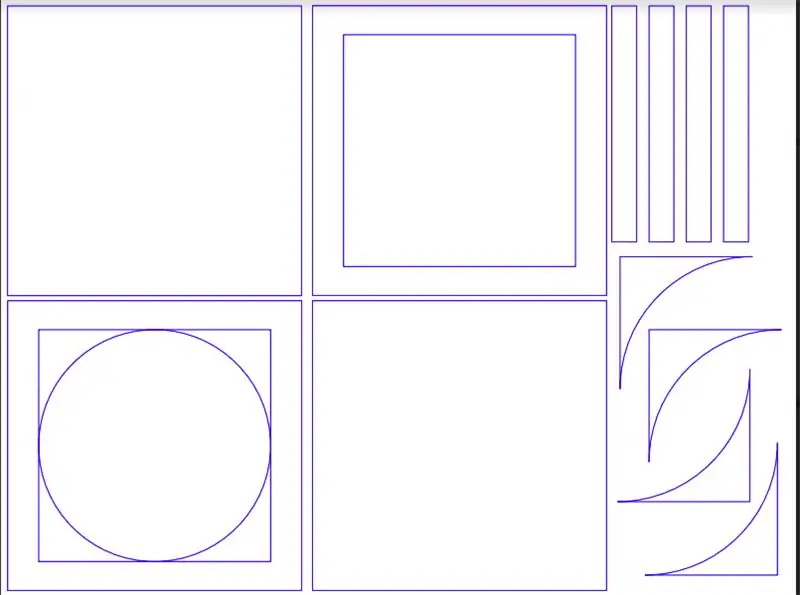


Tegning av formen passer i betongboksen og kutt den med laserskjæring.
Jeg bruker dette til å lagre forskjellig plass inne i esken: refleksjonsrommet og kretsrommet. Jeg legger enveis speilvindufilm og dobbel sidespeilfilm på akrylrutene hver.
Trinn 5: LED -stripe

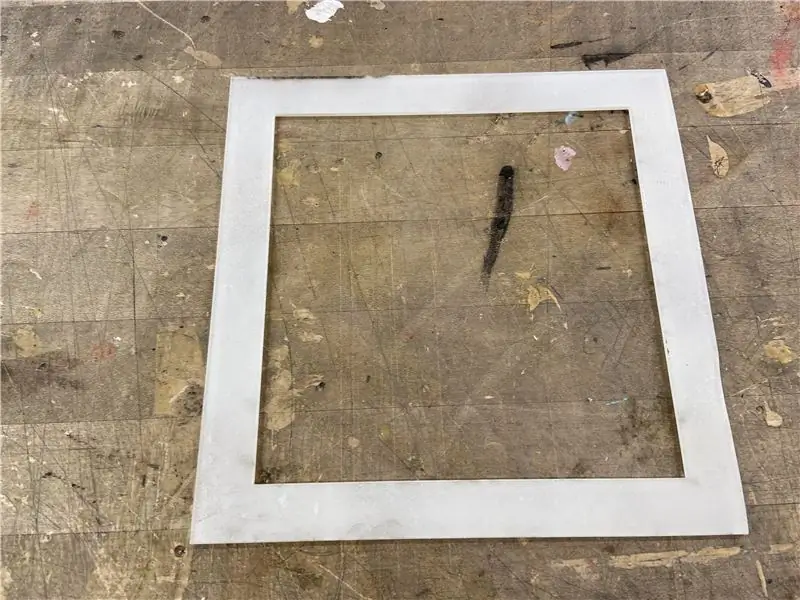
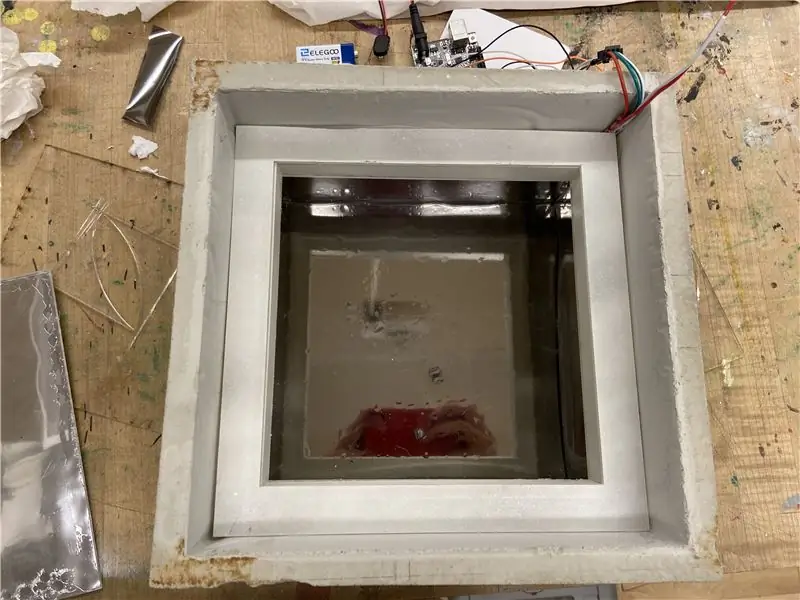
(Utsikt fra bunnen av esken)
Jeg setter enveis speilfilm først, speilsiden vender inne i esken. Og spray hvit farge på rammen for å lage et halvt gjennomsiktig rør for LED-stripen og plasser den i midten av esken.
Trinn 6: Krets
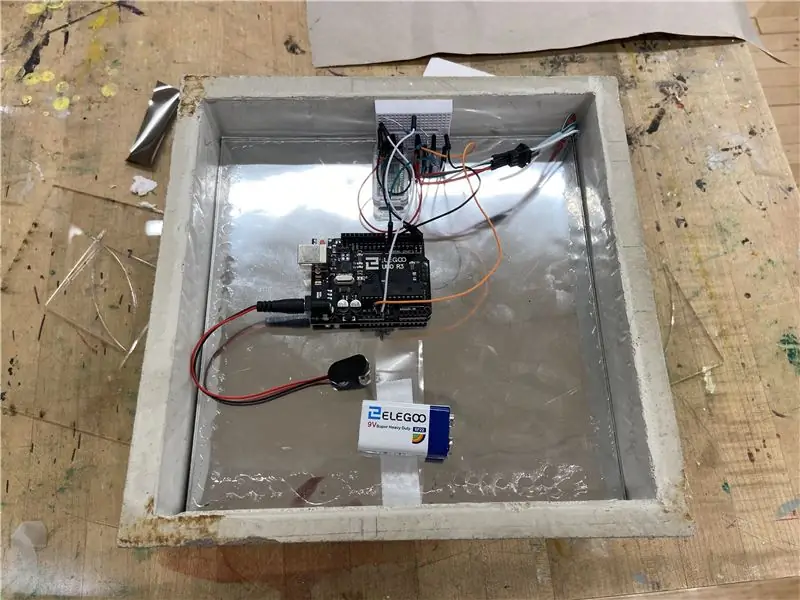
Sett det dobbelte sidespeilet akryl på toppen av LED -en og fest kretsen.
Anbefalt:
En annen stort sett 3D -trykt rotasjonsbryter: 7 trinn (med bilder)
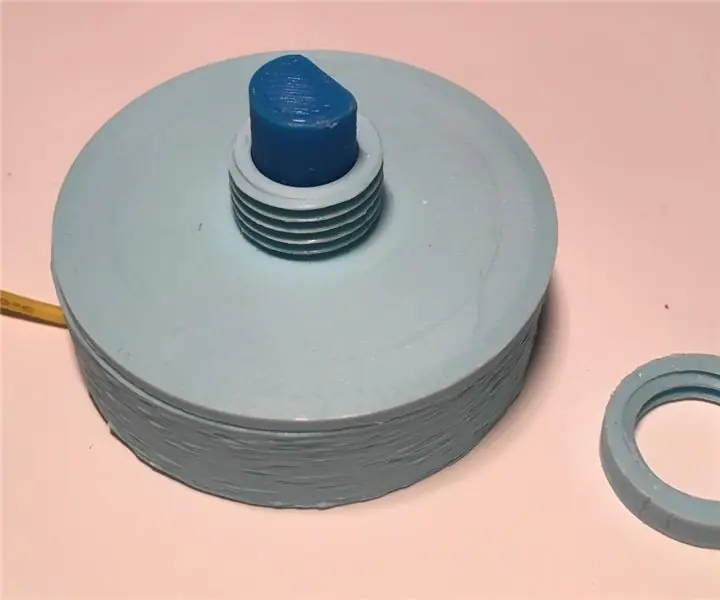
En annen hovedsakelig 3D -trykt rotasjonsbryter: For en stund siden opprettet jeg en hovedsakelig 3D -trykt rotasjonsbryter spesielt for Minivac 601 -replika -prosjektet. For mitt nye Think-a-Tron 2020-prosjekt trenger jeg enda en dreiebryter. Jeg leter etter en SP5T panelmonteringsbryter. Et tillegg
En annen MIDI til CV -boks: 7 trinn (med bilder)
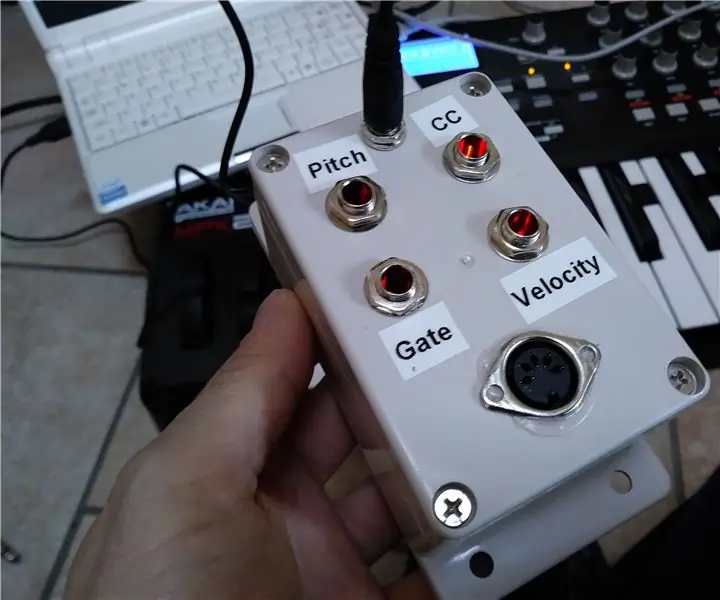
En annen MIDI til CV -boks: En annen MIDI til CV -boks er et prosjekt jeg utviklet da en Korg MS10 banket på døren min og fant sted i studioet mitt. Siden oppsettet mitt er sterkt knyttet til MIDI for å automatisere og synkronisere alle instrumentene, da jeg kjøpte MS10 det første problemet jeg hadde
MIDI 5V LED Strip Light Controller for Spielatron eller annen MIDI Synth: 7 trinn (med bilder)
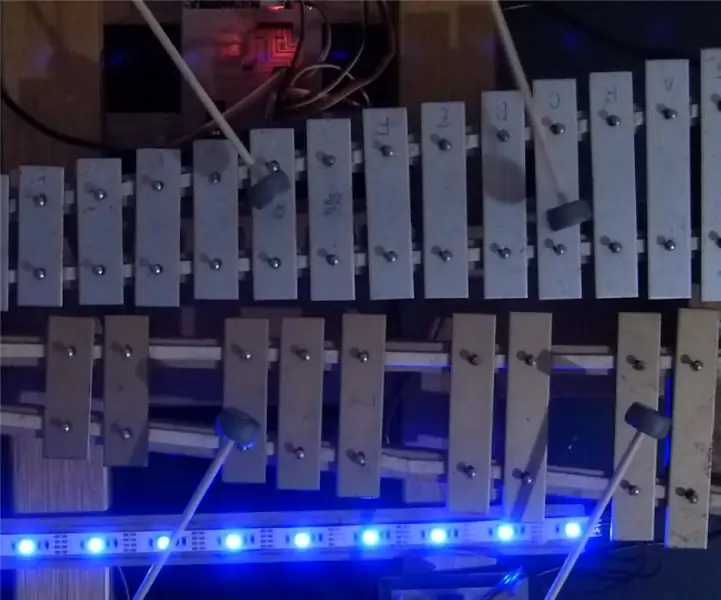
MIDI 5V LED Strip Light Controller for Spielatron eller annen MIDI Synth: Denne kontrolleren blinker trefargede LED stripelys for 50mS per note. Blå for G5 til D#6, rød for E6 til B6 og grønn for C7 til G7. Kontrolleren er en ALSA MIDI -enhet, slik at MIDI -programvare kan mates ut til lysdiodene samtidig som en MIDI -synthenhet
Mestre din mikro: bit med Arduino IDE-knapp og annen GPIO: 3 trinn (med bilder)
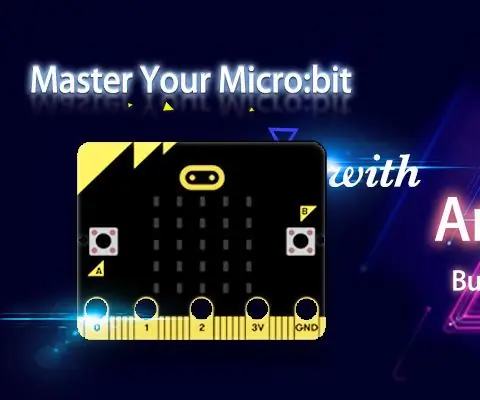
Master din mikro: bit Med Arduino IDE-Button and Other GPIO: I vår forrige blogg Master Your Micro: bit med Arduino IDE - - Light LED, vi har snakket om hvordan du installerer micro: bit bibliotek på Arduino IDE og hvordan å kjøre LED på micro: bit med Arduino IDE. I denne artikkelen skal vi fortelle deg
64 Pixel RGB LED -skjerm - En annen Arduino -klon: 12 trinn (med bilder)

64 Pixel RGB LED -skjerm - Nok en Arduino -klon: Denne skjermen er basert på en 8x8 RGB LED -matrise. For testformål ble det koblet til et standard Arduino -kort (Diecimila) ved hjelp av 4 skiftregistre. Etter å ha fått det til å fungere, permatiserte jeg det på en PC med PC. Skiftregistrene er 8-biters brede og
